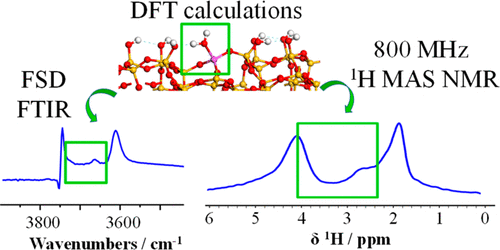Abstract
The nature and spectroscopic expression of external surface sites of zeolites, in particular ZSM-5, is a long-debated question. Herein, we use three cutting-edge techniques: Fourier-transform infrared spectroscopy (FTIR) with Fourier self-deconvolution (FSD), high magnetic field proton NMR spectroscopy under fast magic-angle spinning (MAS) and periodic boundary Density Functional Theory (DFT) calculations to study external surface models and analyze the effect of crystallite size. This provides an unequaled description of the various kinds of hydroxyl groups and of their proximities. The hydrogen-bond donor, acceptor or isolated nature of the hydroxyls results in distinct signals both in FTIR and NMR spectra, but the peak assignment is not the same from one technique to the other when the chemical nature of the hydroxyl changes. Bridging Si–(OH)–Al groups and Al–(H2O) lead to overlapping signals in one-dimensional 1H MAS NMR, whereas their contributions are strongly different in FTIR spectra. However, quantification and proximity assessment could only be obtained by 1H MAS NMR. With DFT, we confirm previous assignments for silanols and Si–(OH)–Al bridging OH groups. Other signals (between 3750 and 3600 cm–1, and between 1 and 4 ppm) are not only assigned to extra-framework species (which we confirm with dedicated models), but also enclose the signature of sites exposed at the external surface of ZSM-5. In particular, Al–(H2O) species (∼3665 cm–1; 3.8, 2.6 ppm) and silanol–Al (∼3740, 3720, 3665 cm–1; 2.6, 2.2 ppm) contribute to several features depending on their environment. μ1-Al–OH are also present at the external surface in low amount, with a 3780 cm–1 signal in IR, and weak signals in the 0–2 ppm interval in 1H MAS NMR.
Laureline Treps, Coralie Demaret, Dorothea Wisser, Bogdan Harbuzaru, Alain Méthivier, Emmanuelle Guillon, Denys Viktorovych Benedis, Axel Gomez, Theodorus de Bruin, Mickaël Rivallan, Leonor Catita, Anne Lesage, and Céline Chizallet
https://doi.org/10.1021/acs.jpcc.0c10200
The Journal of Physical Chemistry C
Publication Date:January 12, 2021

